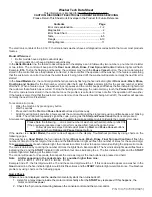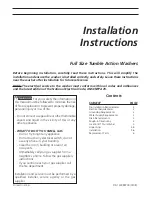
Pressure Washer Operating Features
PRESSURE ADJUSTMENTS (FIG. 19)
The pressure setting is preset at the factory to achieve
op ti mum pres sure and cleaning. If you need to lower the
pres sure, it can be accomplished by these meth ods.
1. Back away from the sur face to be cleaned. The
further away you are, the less the pressure will be on
the surface to be cleaned.
2. Change to the 40˚ nozzle (white). This nozzle
delivers a less powerful stream of water and a wider spray pattern. Refer to How To Use Spray Wand.
3. This pressure washer’s high pressure pump is equipped with an additional feature that allows the
pressure setting to be adjusted.
To lower the pressure, turn the pressure control knob on the pump counterclockwise to the desired
pressure.
To return the pump pressure to the factory setting, turn the pressure control knob on the pump
clockwise until it stops.
DO NOT overtighten the pressure control knob, if overtightened the knob COULD break and
result in immediate loss of water pressure and costly repairs to the unit.
How To Use Spray Wand
The nozzles for the spray wand are stored in the nozzle holder on the panel assembly. Colors on the panel
identify nozzle location and spray pattern. Refer to the following chart to choose the correct nozzle for the
job to be performed.
NOZZLE
COLOR
SPRAY
PATTERN
USES
SURFACES*
Red
0˚
powerful pinpoint
for spot cleaning
of hard, unpainted
surfaces or for high
reach areas
unpainted metal or
concrete;
DO NOT use on wood
Yellow
15˚
intense cleaning
of unpainted hard
surfaces
grills, driveways, concrete
or brick walkways,
unpainted brick or stucco
Green
25˚
intense cleaning of
larger areas
metal, concrete or wood
White
40˚
cleaning of painted
or delicate surfaces
Auto/RV, marine, wood,
painted brick and stucco,
vinyl, painted siding
Black
low pressure
applies cleaning
solutions
Low pressure spray is safe
on all surfaces. Always
verify compatibility of
cleaning solution prior to
use.
The high pressure spray from your pressure washer is
capable of causing damage to surfaces such as wood, glass,
automobile paint, auto striping and trim, and delicate objects such as flowers and
shrubs. Before spraying, check the item to be cleaned to assure yourself that it is
strong enough to resist damage from the force of the spray.
MAINTENANCE /
REP
AIR
TROUBLESHOOTING
OPERA
TION
ASSEMBL
Y /
INST
ALLA
TION
SAFETY /
SPECIFICA
TIONS
GETTING ST
AR
TED
11
-
+
Figure 19














































